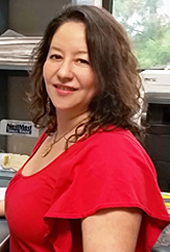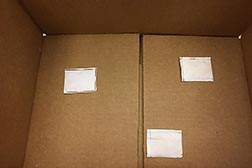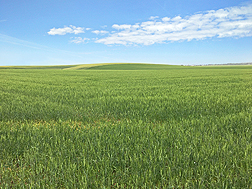January 2018
FNRB Index | Search | Comments
Contents
Chlorine Dioxide Pouches Can Make Produce Safer and Reduce Spoilage
Salmonella Vaccine Reduces Animal Disease and Foodborne Illness
Breeding Pathogen-Resistant Chickens for Improved Food Safety
A Faster, Less Costly Way to Process Walnuts
Heat-Tolerant Broccoli for the Future
Exploring a World Without Food Animals
ARS Honors Scientist of the Year for Groundbreaking Work with Food Allergies
Soft Durum Wheat Opens Door to Expanded Food Uses
Bringing Persimmons into the Limelight
Chlorine Dioxide Pouches Can Make Produce Safer and Reduce Spoilage
A small plastic pouch that releases chlorine dioxide gas to eliminate E. coli and other pathogens from the surfaces of fruits and vegetables could soon be making the nation's produce safer. When the pouches were added to cartons of grapefruit under typical packing, shipping and storage conditions, researchers found 10 times fewer bacterial and fungal pathogens than on grapefruit stored without the pouches. Tests also showed a 100,000-fold reduction in E. coli levels in inoculated grape tomatoes stored with the pouches. The pouch, half the size of a credit card, was developed with help from ARS scientists who designed a polyethylene terephthalate ("PET") clamshell to house it. Worrell Water Technologies of Delray Beach, Florida, hopes to market the product to produce wholesalers and packers in the United States and overseas. The pouches are used by packing them in shipping containers with produce.
For details, contact: Jinhe Bai, (772) 462-5880, U. S. Horticultural Research Laboratory, Fort Pierce, Florida.
Salmonella Vaccine Reduces Animal Disease and Foodborne Illness
A new vaccine developed by ARS scientists in Ames, Iowa, can protect food animals such as pigs against both human- and animal-disease-causing Salmonella. In experiments, the vaccine protected pigs against two types of Salmonella-Typhimurium and Choleraesuis. It also protected turkeys against Typhimurium and a multidrug-resistant Salmonella type, Heidelberg-the bacterium responsible for a 2011 outbreak in ground turkey. The scientists believe that the vaccine will protect against other types of Salmonella in addition to the three strains tested. ARS has filed a patent application for this vaccine technology.
For details, contact: Shawn Bearson, (515) 337-7455, Food Safety and Enteric Pathogens Research Unit, National Animal Disease Center, Ames, Iowa.
Breeding Pathogen-Resistant Chickens for Improved Food Safety
A new test developed by ARS scientists in College Station, Texas, could make it easier to breed pathogen-resistant chickens. The test identifies roosters whose blood contains naturally high levels of two key chemicals, cytokines and chemokines. These chemicals mobilize the birds' innate immune response. Protecting chickens from pathogens involves sanitation, vaccination, biosecurity and use of antibiotics and other medications. But some chickens have an especially robust and efficient immune response and can resist pathogens. Using the new test, commercial poultry breeders can single out roosters that have a strong immune response and use them to selectively breed a more robust flock.
For details, contact: Christina L. Swaggerty, (979) 260-9397, Food and Feed Safety Research Unit, Southern Plains Agricultural Research Center, College Station, Texas.
A Faster, Less Costly Way to Process Walnuts
ARS scientists have developed infrared technology to improve commercial processing, particularly drying of walnuts. Drying walnuts by the current hot-air method is expensive and energy intensive. It takes more than 24 hours and uses a significant amount of natural gas and electricity. Infrared-a form of intense light that's felt but not seen-dries walnuts with 25 percent less energy from natural gas and electricity and reduces drying time by 35 percent. This new infrared drying method also may be practical for other types of nuts, such as pistachios.
For details, contact: Zhongli Pan (John), (510) 559-5861, Healthy Processed Foods Research Unit, Western Regional Research Center, Albany, California.
Heat-Tolerant Broccoli for the Future
ARS scientists are looking to change broccoli's place as a cool-weather crop by developing new varieties that grow in warm temperatures. They have identified genetic markers associated with heat resistance and characterized the genetic sources of broccoli's heat tolerance and the ability to tolerate heat stress. Encountering high temperatures is the main factor limiting where and when broccoli is grown. Total U.S. annual broccoli consumption (fresh and frozen) grew from about 1 pound per person in the 1960s to about 8 to 9 pounds per person today. One cup of broccoli provides more than 100 percent of our daily requirement for vitamins C and K and is a good source of fiber, vitamin A, folate and potassium.
For details, contact: Mark W. Farnham, (843) 402-5301, U.S. Vegetable Research Laboratory, Charleston, South Carolina.

Beef cattle in a feedlot.
Exploring a World Without Food Animals
Researchers with ARS and Virginia Tech recently found that shifting land usage from food animal production to food crop production would increase the total U.S. food supply by 23 percent. Because much of that land is unsuitable for high-value crops, most of the additional food produced would include high-calorie crops like corn and soybeans. They also found that a complete shift away from food animal production would present major challenges to meeting America's nutritional needs. With no meat, milk, eggs, fish, or cheese in their diets, the U.S. population would not receive enough of several different essential dietary nutrients from the foods they eat, according to the study results. For example, eliminating food animals would increase deficiencies in calcium, vitamins A and B12 and some important fatty acids.
For details, contact: Mary Beth Hall, (608) 890-0078, Cell Wall Biology and Utilization Research Unit, U.S. Dairy Forage Research Center, Madison, Wisconsin.

Soheila J. Maleki
ARS Honors Scientist of the Year for Groundbreaking Work with Food Allergies
For her groundbreaking work with food allergies, research chemist Soheila J. Maleki was named the ARS 2017 Distinguished Senior Research Scientist of the Year. Maleki was outstanding in her leadership and research in the field of food allergy, particularly to peanuts and tree nuts. Her accomplishments include defining the biochemical effects of processing on the immunogenicity and allergenicity of food as well as determining the molecular mechanisms involved. For example, Maleki and colleagues showed that raw peanut proteins undergo specific molecular changes during roasting that alter their allergenic properties. This created a new avenue of research in the field of food allergy.
For details, contact: Soheila J. Maleki, (504) 286-4590, Food Processing and Sensory Quality Research Unit, Southern Regional Research Center, New Orleans, Louisiana.
Soft Durum Wheat Opens Door to Expanded Food Uses
Soft Svevo, a new soft durum wheat variety developed by ARS scientists and their collaborators, could expand the market for wheat. Traditional durum wheats are primarily grown as a source of semolina-a coarse meal used to make pasta, couscous and other products. However, producing semolina requires specialized mills that can grind durum wheat's rock-hard kernels. Durum is better adapted to hot, arid growing regions of the United States than the more commonly grown bread wheat varieties. The ARS team determined that durum's hard kernel texture has no relationship to pasta quality. Rather, it is durum's yellow kernel color and high-protein content that gives pasta its desirable firmness. Finding two genes that control kernel texture in soft bread wheats-Puroindoline a (Pina) and Puroindoline b (Pinb)-proved a breakthrough. The team moved these genes into a prized Italian durum variety to eventually produce Soft Svevo, marking the first soft durum of its kind. Tests show that Soft Svevo's flour is similar to soft bread wheat flour. It imparts an appealing aroma, flavor and color to pizza crusts, baguettes and other baked goods.
For details, contact: Craig Morris, (509) 335-4062, Wheat Health, Genetics, and Quality Research Unit, Pullman, Washington.

ARS scientists identified the best cultivars for making dried chip-style persimmons.
Bringing Persimmons into the Limelight
Persimmon is a sweet, flavorful fruit that hasn't gotten much attention. California produces 99 percent of the U.S. persimmon crop. The fruit, which is high in vitamin C, varies in shape and color. The most common market types are Fuyu and Hachiya. Fuyu persimmons are light yellow-orange with a tomato- or pumpkin-like shape. Hachiya persimmons are dark orange with an acorn-like shape. The availability of fresh persimmons is limited outside of California, and the fruit is only available for three months-typically late September through December. ARS researchers are developing ways to dry persimmons so the fruit will be available year round, which may help growers increase profits. They are also working with collaborators and the industry to select the best cultivars for commercial and home drying.
For details, contact: Andrew Breksa, (510) 559-5898, Healthy Processed Foods Research Unit, Western Regional Research Center, Albany, California.







